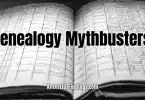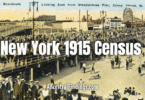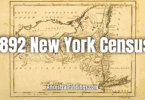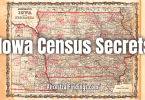By 1830, the United States had reached a new kind of maturity. For some, the Revolution was no longer in living memory, though a surprising number of veterans were still alive and tucked into households across the country. Andrew Jackson was president, the Erie Canal had transformed trade in the North, and the South was leaning heavily on slavery and cotton. The country was bigger, louder, more divided, and more connected than ever.
And right in the middle of that, the federal government rolled out its fifth census. This one looked a little closer. It counted a little smarter. And for those of us digging into family history, it quietly handed us some of the most valuable clues of the early census years.
What Made the 1830 Census Different?
If you’ve worked with the 1810 or 1820 census, you know what a headache it can be trying to figure out who’s in a household of tick marks. But in 1830, those tick marks started to tell a better story.
For the first time, the census listed the age of every free person—male and female—in ten-year bands up to 100 years and older. That means you could look at a household and see, for example, a woman between 70 and 79 living with a younger couple and their children. That’s probably someone’s mother or mother-in-law. You couldn’t always prove it from the census alone, but it’s the clue that can send you looking in the right direction.
They also counted enslaved individuals in the same detailed age brackets, which helps when tracing enslaved ancestors or studying the structure of a plantation household. It’s still impersonal—names are missing—but you can begin to estimate birth years or identify patterns when comparing across years.
This was also the first census in which the government noted military service for Revolutionary War veterans—not in the household entries but in separate schedules. It’s worth knowing that those existed, even though many of them were later lost or not preserved, as were the population schedules.
More Precise Age Groupings
The 1830 census broke free from the vague categories of earlier counts. Children were now divided more finely, adults were tracked more closely, and people over sixty were given far more attention than before. For researchers, that means you can estimate birth years with more confidence.
I’ve used the 1830 census to distinguish between brothers or cousins with the same name. If one head of household is 30–39 and the other is 40–49, you can line that up with land records, tax rolls, or wills, and finally figure out which is which. The census helps narrow the field when names are reused repeatedly.
Tracking Elderly Ancestors
Here’s where this census shines: it often shows elderly parents living with their children. Someone born before 1770—possibly even the 1760s or earlier—might appear in one of those upper age brackets, quietly living in the household of a son or daughter. For a family historian, that’s a gift.
In some cases, I’ve seen widowed mothers or disabled veterans show up as the only person in their age range on the page. That lone mark under “Female 80 to 89” can be the only surviving record of a woman’s old age, especially if she outlived her husband by decades and didn’t appear in court records or land deeds.
It’s a reminder that while these people weren’t named, their presence still echoes through the page.
Who Was Counted—and How
The 1830 census counted every free person in the United States, every enslaved person, and other free nonwhite individuals. As always, only the head of household was named. Everyone else was grouped into age and gender categories, divided into neat columns across the page.
Census takers—still U.S. marshals and their assistants—used printed forms again, which helped create a more consistent record nationwide. But the quality still depended on who was holding the pen. Some pages are neat and orderly. Others are smudged, rushed, or out of alignment, so you must carefully count columns to ensure you’re reading the right one.
There were also a few cases where census takers made margin notes—scribbles that aren’t official but sometimes explain something unusual about the household. I’ve run across notations like “blind,” “widow,” or “house burned.” They aren’t common, but when they show up, they’re worth noting.
Clues for Tracking a Family’s Movement
By 1830, migration was picking up speed. Families were packing wagons and heading to Arkansas, Michigan, and Missouri. You can often track this movement from census to census by looking at age patterns. Let’s say you find a head of household in Ohio with children between 5 and 15 years old. The father is in the 30–39 age range. That likely means the family moved to Ohio sometime around 1820 or just after. If they weren’t in Ohio in 1820, they may have been in Pennsylvania, Virginia, or Kentucky. I check land records and church rolls to trace their path from there.
Sometimes, younger adults—sons and daughters in the 15–19 or 20–29 brackets—are living with their parents in 1830 but move out on their own by 1840. That allows me to build a timeline of when children came of age, got married, or left home. It’s small but enough to start threading together baptisms, marriage bonds, or land purchases.
Genealogy Tips from the 1830 Census
One of the most valuable things I’ve done with this census is build out family groupings using the age breakdowns. If I see two men with the same name in different counties, and one household has a female aged 60–69 while the other doesn’t, that helps me figure out who’s more likely to be the son of a widow or the older brother. Age distribution becomes a kind of fingerprint.
It also helps to look at neighbors. In 1830, families often lived near each other—parents on one plot, children on another, in-laws next door. Suppose you can spot similar surnames grouped, which might signal a cluster of extended family. I once traced a line of five brothers by noticing that each had a head-of-household listing just a few houses apart from the others across two pages.
I also check whether someone’s household is shrinking. If they had ten children in 1820 and only three minors remained in 1830, you’ve got a good window for when the older ones left home. That lets you start checking for marriage or land records in the same county.
And if someone appears for the first time in 1830, with no trace in the 1820 census, that’s often a sign of either westward migration or a coming-of-age moment where a son is now listed as head of his household. I’ll then check local tax rolls a year or two earlier to see if he showed up before buying land.
My Final Thoughts
The 1830 census is still limited in what it gives you, but it quietly opens the door to some of the best early research you can do. It helps you estimate birth years, track older relatives, narrow down family groups, and spot newcomers in a county. With some patience, it becomes more than a list of tick marks. It becomes a map.
Behind each set of numbers is a life in motion. A household growing or shrinking. A mother growing old with her children. A son striking out on his own. A Revolutionary War veteran living out his final years under his daughter’s roof. These aren’t just statistics. They’re the turning points that help us see our ancestors not just as names, but as people making choices in a changing country.
If you’re tracing families in the early 1800s, the 1830 census might be the quiet workhorse in your toolbox. It won’t give you headlines. But it will provide enough clues to keep you moving forward, one column at a time.
Connecting the 1830 Census to Revolutionary War Pension Records
One of the quiet gifts of the 1830 census is the chance to trace Revolutionary War veterans—not through obvious labels but through patterns and connections you can follow with a bit of digging.
By 1830, many men who had fought in the Revolution were in their 70s and 80s, often living with adult children or grandchildren. Some were heads of households, but many were not. They don’t always stand out in the census, but their pension records—if they applied for one—can shine a light on their final years. And if you compare those pension files with the census, you can often place them exactly where they were living and who was caring for them.
Congress passed a major pension act in 1832, just two years after this census. That act opened the door for any surviving Revolutionary War veteran to apply for a pension, even if he hadn’t been injured or didn’t serve for long. As a result, thousands of elderly men came forward and told their life stories in handwritten applications—where they lived, who they served with, how old they were, and in many cases, who they were living with at the time.
Some of the best stories I’ve come across in early American genealogy came straight from those pension files. One veteran wrote about being a drummer boy at the Battle of Brandywine. Another described hiding in cornfields in North Carolina while British troops swept through the area. Some lived with sons, daughters, or neighbors who gave sworn statements confirming the veteran’s age and service.
Here’s where the census comes in: if you see a man in the 1830 census listed as 70 to 79, living with younger adults, and you suspect he was a veteran, you can check the Revolutionary War Pension and Bounty-Land Warrant Application Files on websites like Fold3 or through the National Archives. If he applied in 1832, there’s a good chance his file will tell you exactly who he was living with—and in many cases, that matches up with the census household you found earlier.
Sometimes, the pension file gives you the names of adult children or grandchildren. Other times, it names neighbors who served alongside him, and those names may appear just a few households away in the 1830 census. The connections start to form quickly once you know what to look for.
It’s also worth checking for widows of veterans, especially if there’s a woman in the 70–79 or 80–89 age range living alone or with a son. Some widows applied for their husband’s pension after his death, often in the 1840s or later, but their household may still appear in the 1830 census. If the man died just before the census was taken, the widow might already be listed under her name as head of household.
These pension files can stretch across several pages—sometimes dozens—and include family Bibles, letters, affidavits, and detailed memories of life before the country was fully formed. And when you pair them with the quiet columns of the 1830 census, they start to come to life.
So if you’re tracing ancestors born in the mid-1700s who lived into their seventies or beyond, take a closer look at the 1830 census. Look for those older age groups. Follow the households where they appear. Then turn to the pension records and see if their story was told. You might be surprised by how much they left behind.






